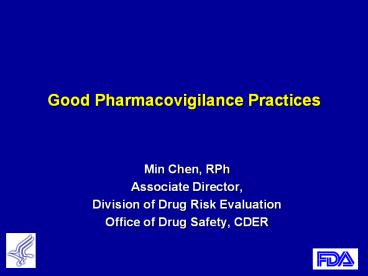Good Pharmacovigilance Practices PowerPoint PPT Presentation
1 / 15
Title: Good Pharmacovigilance Practices
1
Good Pharmacovigilance Practices
- Min Chen, RPh
- Associate Director,
- Division of Drug Risk Evaluation
- Office of Drug Safety, CDER
2
What is Pharmacovigilance?
- Is generally regarded as all postapproval
scientific and data gathering activities relating
to the detection, assessment, understanding, and
prevention of adverse events or any other
product-related problems - This includes the use of pharmacoepidemiologic
studies
3
Good Pharmacovigilance Practice starts by
acquiring complete data from spontaneous adverse
event reports
4
Characteristics of a Good
Case Report
- Adverse event(s) details
- Baseline patient characteristics
- Therapy details
- Time to onset of signs or symptoms
- Diagnosis of the event(s)
- Clinical course of the event and outcomes
- Laboratory data
- Any other relevant information
5
Good Medication Error Report
- Product(s) involved
- Sequence of events leading to the error
- Work environment in which the error occurred
- Types of personnel involved with the error
- Narratives- follow NCC MERP taxonomy (National
Coordinating Council for Medication Error
Reporting and Prevention)
6
Case Series Development
- Includes spontaneous case reports and scientific
literature case reports - Good database search strategies using MedDRA
terminology - Case definitions may be developed to provide
consistent characterizations of the adverse
events, and to facilitate retrieval of all
clinically relevant cases
7
Assessing Causality
- It is rarely certain whether an event is product
induced - Features supportive of an association
- event occurred in the expected timeframe
- absence of symptoms prior to exposure
- absence of co-morbid conditions or use of
concomitant medications - () dechallenge, () rechallenge
- event consistent with the established mechanism
of action of product - Grouping case reports into probable,
possible, and unlikely when appropriate
8
Safety Signals
- An apparent excess of adverse events associated
with a products use - a single well-documented case report may be
viewed as a signal - preclinical findings
- experience with other similar products in the
class - May be further assessed in terms of magnitude,
population at risk, changes in risk over time,
biological plausibility and other factors
9
Data Mining As a Signaling Tool
- Uses raw case report data and arrays of all
drug-adverse events combinations - Calculates expected (E) number of events for
all drugs, then compares each drugs observed
(O) to expected - Various methods may be used to generate relative
signal scores (intensity) of OE - May be useful adjunct to routine safety signaling
methods - Further exploration and validation is needed
10
Safety Signals May Be...
- New unlabeled adverse events
- An observed increase in the severity or
specificity of a labeled event - An observed increase in the frequency of a
labeled event - New interactions
- Confusion with a products name, packaging or
use, either actual or potential
11
Understanding Safety Signals
- Demographics - age, gender, race
- Effect of exposure duration and dose
- Relationship between concomitant medications and
potential interactions and the risk of event - Relationship between co-morbid conditions and the
risk of event
12
Understanding Safety Signals (contd)
- Effects of lot-to-lot variation and differences
in product formulation and the risk of the event - Potential for an excess of adverse events given
the disease being treated - Estimates of the magnitude of risk or differences
from known background rates
13
Questions for Public Comment
- How can the quality of spontaneously reported
case reports be improved?
14
Questions for Public Comment
- What are possible advantages or disadvantages of
applying data mining techniques (e.g., empirical
Bayesian techniques, proportional reporting
ratios) to spontaneous reports databases for the
purpose of identifying safety signals?
15
Questions for Public Comment
- What are possible advantages or disadvantages
of performing causality assessments at the
individual case level?

